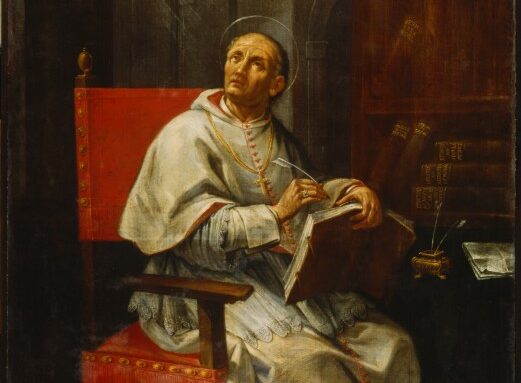In the 11th century God raised up a heroic man who, consumed with love for the Church, fought especially against the internal enemies of the Bride of Christ: Saint Peter Damian.
Newsdesk (01/09/2022 08:07 AM, Gaudium Press) He was born in 1007 in the city of Ravenna, north-east Italy. Orphaned of both father and mother at the age of five, one of his neglected brothers took him onto his property, forced him to tend pigs and to live in a hut.
His older brother, having become a clergyman, helped him so that he could study at Fontavellane Monastery, where he made marked progress in the supernatural and cultural life.
Blade of the avenging sword
Angered by the moral decadence of elements of the clergy, who were wallowing in sins against chastity, he wrote the “Book of Gomorrah” and sent it to Pope Saint Leo IX, who sent him a letter which said:
“You have just armed your hand against the barbarism of the flesh […] Your word, preserving the reserve of a holy modesty, strikes like the blade of the avenging sword.”
Shortly afterwards, another pontiff wanted to make him a cardinal, but he refused. Threatened with excommunication if he did not accept the post, he respectfully accepted the order and became Cardinal Bishop of Ostia, a city near Rome.
As soon as he took office, he sent a letter to all the cardinals in which he stated:
“The profaned priesthood has become the scandal of the peoples; the canon laws are trodden under foot; the priestly ministry has passed from the service of God to that of shameful concupiscence.”
Martyrdom of St. Arialdo
The Archbishop of Milan was a simoniac and practically all the priests of the diocese had concubines.
Against this debauchery a movement arose, led by virtuous clerics and supported by the people, which was called “Pataria”. Its members took an oath to walk through the towns and countryside, preaching against the debauched clerics and defending priestly celibacy.
The Bishop of Lucques, of a noble family from north-west Italy, was the founder and leader of the Pataria. He became Pope in 1061 under the name Alexander II.
The enemies of the Church hated true Catholics so much that they went so far as to kill one of the leaders of the Pateria, St. Arialdo, with the utmost cruelty.
By order of the Archbishop of Milan, two priests took him to a dungeon near Lake Major – Italy’s border with Switzerland – where they cut off his ears, pierced his eyes, did an ignominious mutilation for being in favour of celibacy, cut out his tongue and threw him into the lake.
“Armies of the Earth in the service of the King of Heaven”
The simoniacs and depraved people violently opposed Alexander II and began to defend the King of Germania Henry IV who, although very young, had already contaminated himself with bad ideas and even supported an anti-pope.
Saint Peter Damian wrote to Henry IV, calling the antipope the “firstborn of Satan”, recommended the king to turn away from the schismatics and take a “manly resolution”. He added:
“You are, according to St. Paul’s expression, ‘the minister of God for good; that is why you bear the sword’. Stand up then in the name of the Lord for the defence of his Church. What good is armour if you do not fight, a sword if you do not strike the enemies of God? […] Show that you are the worthy heir of the Faith, of the courage, of the virtues of your forefathers; after their example put the armies of the earth at the service of the King of Heaven.”
Henry IV, hardened in evil, was not moved, but his mother, the Empress Agnes, who supported the antipope, was converted and asked St. Peter Damian to guide her spiritually,
Invasion of the Monastery of Cluny
In 1064, the Archbishop of Mâcon – Eastern France- with his troops invaded the Monastery of Cluny. The Abbot Saint Hugo begged Alexander II for help, who sent Saint Peter Damian to suppress this nefarious action, bearing a letter in which he said:
“The legate charged with representing us is the great man who, after us, holds the first office in the Roman Church. He is Peter Damian, Bishop of Ostia, our right eye, the unshakable pillar of the Apostolic See.”
As Saint Peter approached Cluny, the infamous invading archbishop withdrew from the monastery and all the faithful monks received the Saint with joy. He later wrote that Cluny seemed to him “an intermediate paradise between Earth and Heaven”.
King Henry IV Upbraided
In 1069, Alexander II sent St. Peter to Frankfurt in central-west Germany to preside over a council, which included Henry IV, who wished to divorce his wife. The saint rebuked the monarch for wanting to practice such a sin and was supported by the authentically Catholic nobles.
Shortly afterwards, the Pope sent him to Ravenna, whose schismatic archbishop had died in final impenitence. The inhabitants welcomed him with great joy, and those who had supported the wretched archbishop prostrated themselves at his feet and abjured the schism.
On his return to Rome, Saint Peter Damian had a violent fever and was taken to a monastery in Faenza, near Ravenna. Late at night he asked the monks to recite Matins. Afterwards Mass was celebrated at which he received communion; during the thanksgiving he went into ecstasy and died. It was January 18, 1072. When the funeral procession took place through the streets, many sick people were cured.
He subsequently received the title of Doctor of the Church and his memory is celebrated on February 21.
To pull the world out of the chaos and the mud in which it is mired
Regarding this great battler of the Church, Dr. Plinio Corrêa de Oliveira wrote:
“We have need of Saints like Saint Peter Damian, today more than ever. We need men who really imitate Our Lord Jesus Christ, to be able to preach Catholicism to the present paganized world.
Vice has spread in such a way that even Catholics do not see in it the insolence of sin, often condoning it because they think it is natural.
“Everywhere sin is seen openly, free from the shame it used to cause in those who practiced it. They boast of sinning, and Catholics are ashamed to proclaim virtue.
“It is necessary, therefore, that men like Saint Peter Damian should multiply, to bring the light of the Gospel to the world again, to bring it out of the chaos and mud in which it has become mired.”
By Paulo Francisco Martos, Concepts of Church History



































